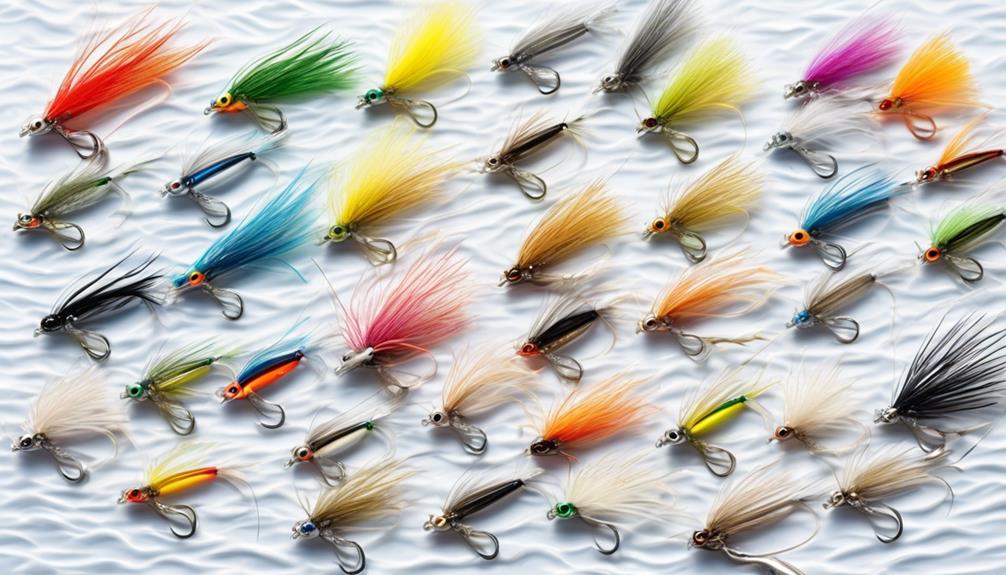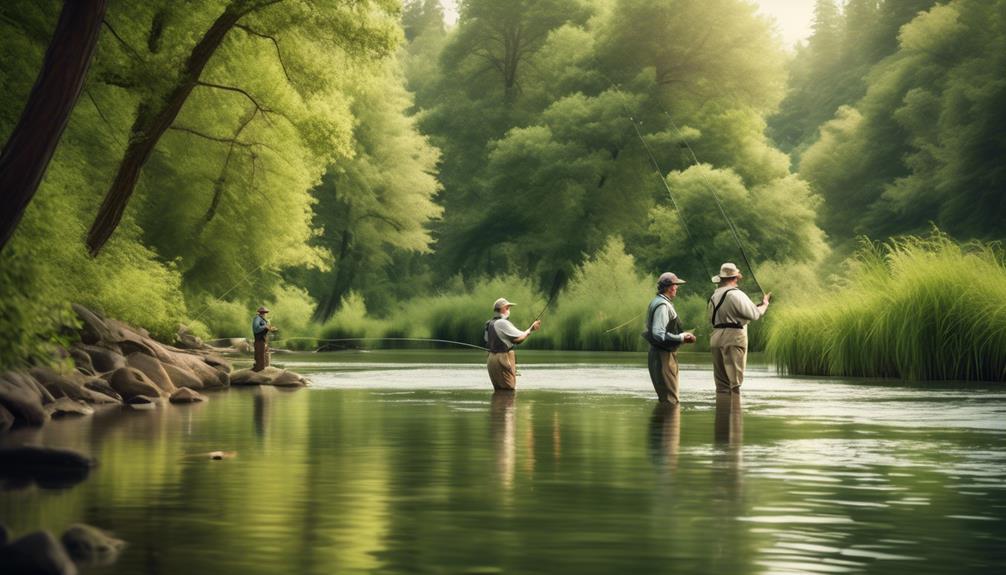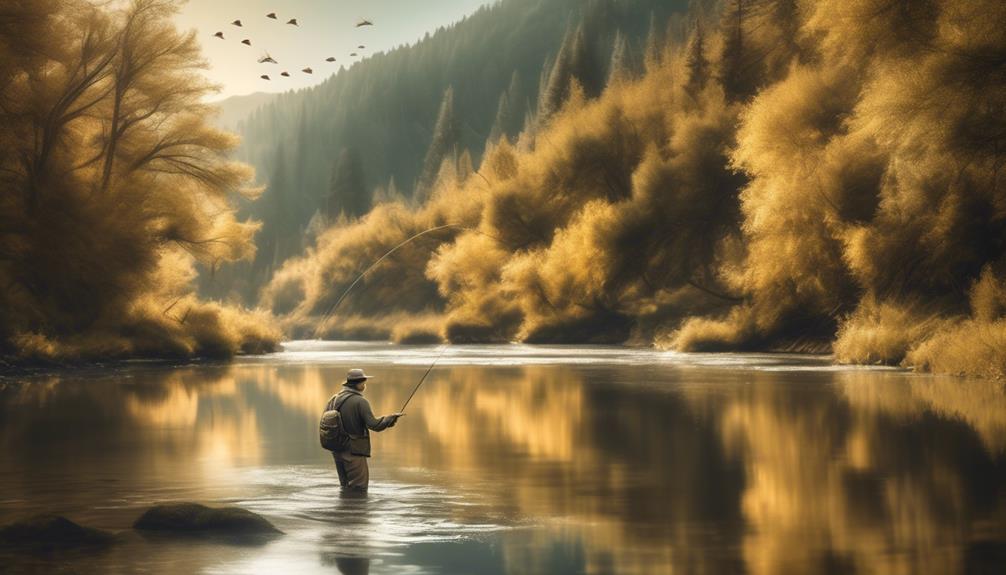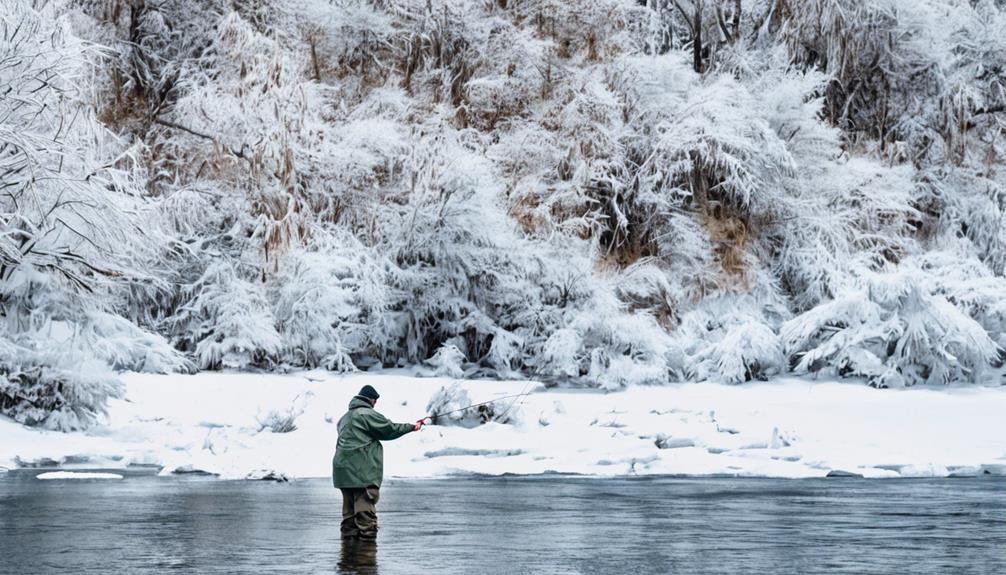Ever wondered which artificial flies are the go-to for successful fly fishing? You may have heard various opinions on the matter, but how do you know which ones actually work best?
There's a lot to consider when it comes to selecting the top artificial flies for fly fishing, from the type of water you're fishing in to the specific species of fish you're targeting.
But fear not, because by the end of this discussion, you'll have a clear understanding of the top artificial flies that can significantly improve your fly fishing game.
Dry Flies
When selecting dry flies for fly fishing, choose patterns that closely resemble the insects present on the water's surface. Fly tying techniques play a crucial role in creating realistic imitations of these insects. Understanding the insects in the area and their life cycles is essential for effective fly tying. Different fly fishing locations will have different insect species, so it's important to research and be prepared with the appropriate patterns.
Fly tying techniques require attention to detail. To imitate the look of insects, consider using materials like feathers, fur, and synthetic materials to construct the fly. Mimicking the size, shape, and color of the natural insects is key to enticing fish to take the fly. Many fly fishing locations have local fly shops or workshops where you can learn these techniques from experienced anglers or purchase handmade flies specific to the area.
When fly fishing in different locations, it's essential to have a variety of dry flies to match the local insect hatches. For example, in a location with abundant mayflies, having a selection of mayfly patterns in various sizes and colors is crucial. Research the specific insects in the area and have patterns that imitate them. This will increase your chances of success when fly fishing in diverse locations.
Nymph Flies
To continue your exploration of fly fishing, consider the effectiveness of nymph flies. Nymph flies are crucial for imitating underwater insect life and enticing fish to strike. They are designed to resemble the immature forms of aquatic insects, such as mayflies, caddisflies, and stoneflies. These insects are a primary food source for freshwater fish. Mastering nymph fly tying techniques is essential for creating realistic imitations of these aquatic insects.
When tying nymph flies, it's important to focus on creating a slender, streamlined body to mimic the natural shape of insect larvae. Incorporating materials that exhibit lifelike movement, such as pheasant tail fibers or marabou, can enhance the fly's effectiveness in attracting fish.
In addition to mastering nymph fly tying techniques, understanding nymph fly presentation strategies is crucial for a successful fly fishing experience. When fishing with nymph flies, it's important to pay attention to the depth at which the fish are feeding. Using weighted nymph flies or adding split shot to the leader can help the fly sink to the desired depth.
Additionally, employing techniques such as dead drifting, where the fly drifts naturally with the current, or incorporating subtle twitches to mimic the movement of an emerging insect can significantly improve the chances of enticing strikes from fish.
Streamer Flies
Streamer flies are long, flowing patterns designed to imitate larger aquatic and terrestrial prey, such as minnows, leeches, and crayfish, in order to attract aggressive strikes from predatory fish. When using streamer flies, it's crucial to employ the right techniques to maximize their effectiveness.
One popular technique is the 'strip and pause' method, where you retrieve the fly with short, quick strips followed by brief pauses to mimic the erratic movement of wounded baitfish. This technique often triggers aggressive strikes from fish, especially in murky or fast-moving waters.
Another effective method is the 'downstream swing,' where you cast the streamer across the current and let it swing across the water before retrieving it. This imitates the movement of a fleeing baitfish and can entice fish lurking in deeper pools or along the riverbanks.
Choosing the best streamer fly colors can significantly impact your fly fishing success. In clear water, natural colors such as olive, brown, and white are generally effective as they closely resemble the hues of actual baitfish. In murky or stained water, brighter colors like chartreuse, orange, and black can be more visible and attract attention from predatory fish.
It's also essential to consider the local forage and prevalent prey species when selecting streamer fly colors. Adapting the color of your streamer fly to match the prevalent food sources in the area can greatly enhance its effectiveness. Remember, experimenting with different colors and techniques is key to finding the optimal combination for a successful day on the water.
Wet Flies
Wet flies offer a versatile and effective approach to enticing fish in various water conditions, providing anglers with a dynamic option for their fly fishing endeavors. Utilizing wet flies involves understanding different fly tying techniques. These flies are designed to imitate underwater insects, baitfish, or other aquatic creatures, and their construction often involves materials that allow them to sink below the water's surface. When tying wet flies, it's essential to consider the weight of the fly, the materials used, and the overall profile to accurately mimic the prey fish are targeting beneath the surface.
When it comes to the best fishing spots for wet flies, look for areas where fish are actively feeding below the water's surface. This includes slow-moving stretches of rivers, deep pools, and areas near submerged structures where fish seek shelter and food. Additionally, during hatches of insects, wet flies can be extremely effective as they imitate the emergent insects or the nymphs that fish actively feed on. Popular wet flies for these conditions include the Pheasant Tail Nymph, Woolly Bugger, and Soft Hackle wet flies.
Incorporating wet flies into your fly fishing arsenal can significantly increase your chances of landing fish, especially when streamer or dry fly action is slow. By mastering the art of tying and presenting wet flies, you can effectively target fish in various water conditions and improve your overall fly fishing success.
Emerger Flies
As you move from targeting fish in various water conditions with wet flies, consider the effectiveness of emerger flies in imitating insects during hatches. When it comes to emerger flies, the tying techniques and materials used are crucial in creating patterns that effectively mimic insects transitioning from the nymph to the adult stage. Understanding the behavior of insects during hatches and the specific materials and tying techniques that replicate these stages is essential in creating successful emerger flies.
One of the best emerger fly patterns is the RS2 (Rim's Semblance 2). This pattern is tied using microfibers, which allows it to imitate the delicate silhouette of an emerging insect. Its slender profile and subtle coloration make it an effective emerger pattern, especially in slow-moving or still water where fish are targeting insects just below the surface.
Another popular emerger pattern is the Sparkle Dun, which is tied with CDC (cul-de-canard) feathers that provide natural buoyancy and an excellent profile on the water's surface. This pattern is particularly effective during mayfly hatches.
When selecting materials for emerger flies, it's important to choose those that impart a realistic appearance and behavior to the fly. Materials such as CDC feathers, antron, and microfibers are commonly used for their ability to trap air and create the illusion of emerging insects.
Terrestrial Flies
When fly fishing in areas with overhanging vegetation or near the edges of water bodies, consider using terrestrial flies to imitate land-dwelling insects and increase your chances of enticing fish. Terrestrial flies, such as grasshopper imitations, are highly effective in imitating these insects that often fall onto the water, attracting the attention of fish. When using grasshopper imitations, try techniques such as casting near the banks and using a twitching motion to mimic the natural movement of these insects. This can lead to explosive strikes from fish lurking in these areas.
Ant patterns are another type of terrestrial fly that can be incredibly productive. These flies imitate ants that accidentally fall into the water, making for an easy meal for fish. When using ant patterns, fishing strategies such as targeting overhanging vegetation and bushes can be particularly effective. These areas often have a high concentration of ants, and when they fall into the water, they can create a feeding frenzy among fish. Additionally, casting these patterns close to the banks and allowing them to drift naturally with the current can yield great results.
Incorporating these terrestrial flies into your fly fishing arsenal can greatly enhance your success, especially in areas with overhanging vegetation and near the edges of water bodies. By using grasshopper imitations and ant patterns with the right techniques and strategies, you can increase your chances of landing that prized catch.
Saltwater Flies

Looking to expand your fly fishing repertoire? Consider adding saltwater flies to your collection, especially if you frequently fish near coastal areas. Saltwater flies are essential for targeting species like bonefish, tarpon, permit, and other saltwater game fish.
When it comes to bonefish patterns, the Crazy Charlie and Gotcha flies are popular choices. These flies are designed to mimic the small crustaceans that bonefish feed on, making them highly effective in shallow saltwater flats.
If you're targeting tarpon, having a selection of tarpon flies is crucial. The Tarpon Toad and Cockroach flies are go-to options for enticing these powerful and acrobatic fish. Their large profiles and flashy materials make them irresistible to tarpon in both clear and murky waters.
When pursuing permit, it's important to have the right flies in your arsenal. Crab patterns like the Del Brown's Permit Fly and the Raghead Crab are known for their effectiveness in enticing these selective and wary fish. These flies are designed to imitate the small crabs that permit feed on, making them a must-have for any saltwater angler targeting this species.
Lastly, saltwater poppers are versatile flies that can attract a variety of saltwater species, including striped bass, bluefish, and even smaller tarpon. Poppers are designed to create surface commotion, attracting predatory fish and inducing explosive topwater strikes. Adding a selection of saltwater poppers to your fly box can greatly enhance your saltwater fly fishing experience.
Bass Flies
Consider adding a selection of bass flies to your collection to target largemouth and smallmouth bass in freshwater environments. Bass flies are designed to imitate the natural prey of bass, such as minnows, frogs, and insects, making them highly effective for enticing these species. When selecting bass flies, it's essential to have a variety of patterns in your arsenal to adapt to different fishing conditions and the bass's feeding habits. Here are some of the best bass fly patterns to consider:
- Clouser Minnow: This versatile fly pattern mimics baitfish and is effective for both largemouth and smallmouth bass. The weighted eyes help the fly to dive and move enticingly in the water, making it a go-to pattern for bass anglers.
- Popper Flies: These surface flies create enticing splashes and movements, making them ideal for topwater action. Popper flies can imitate frogs, insects, or wounded baitfish, and they're incredibly effective for attracting aggressive strikes from bass.
- Woolly Bugger: A classic fly pattern that resembles leeches, baitfish, and even crayfish, the Woolly Bugger is a must-have in any bass angler's fly box. Its versatile design allows for various retrieval techniques, making it suitable for different water conditions.
- Dahlberg Diver: This fly pattern is specifically designed to mimic a struggling or wounded baitfish. Its diving action and lifelike appearance make it a great choice for targeting trophy-sized bass.
When fishing with bass flies, it's essential to master specific techniques to maximize your success. Try these techniques for fishing with bass flies:
- Topwater Retriever: Use a steady retrieve with popper flies to create enticing surface movements that attract bass.
- Strip and Pause: For streamer patterns like the Clouser Minnow, employ a strip-and-pause retrieve to mimic the erratic movement of injured baitfish.
- Bottom Bouncing: When using subsurface patterns like the Woolly Bugger, let the fly sink near the bottom and utilize short, sharp strips to imitate the movement of crayfish or leeches.
- Pulsating Retrieve: With the Dahlberg Diver, experiment with a pulsating retrieve to mimic a struggling baitfish, enticing bass to strike.
Frequently Asked Questions
What Are the Best Fly Fishing Spots for Using Dry Flies?
When using dry flies for fly fishing in Montana, the best spots are along the Madison River and Yellowstone River. Try classic patterns like the Adams or Elk Hair Caddis. In Colorado, head to the Frying Pan River and use Parachute Adams or Royal Wulff patterns.
How Do You Properly Present a Nymph Fly to Trout in a River?
Approach the river with stealth, observing trout behavior. Cast your nymph upstream, allowing for a natural drift. Adjust your line for a drag-free presentation. Be patient, as trout may take time to strike.
What Are the Most Effective Streamer Flies for Targeting Large Trout in Deep Pools?
To effectively target large trout in deep pools, focus on streamer fly techniques and presentation. Choose the right streamer fly pattern based on the size and color of local baitfish. Vary the retrieve speed to imitate fleeing prey.
Can Wet Flies Be Used for Fishing in Still Water, or Are They Best Suited for Rivers and Streams?
When fly fishing in still water like lakes or ponds, wet flies can be effective. Using wet fly patterns in still water fly fishing can entice fish to strike, making them suitable for lakes and ponds as well.
What Are Some Popular Emerger Fly Patterns for Fishing in Fast-Moving Rivers?
When fishing in fast-moving rivers, popular emerger fly patterns for trout can include the RS2, WD-40, and Sparkle Dun. Pay attention to trout feeding behavior and use proper fly selection and fly tying techniques for successful fly presentation.
Conclusion
So, whether you're fishing for trout, bass, or saltwater species, having a variety of artificial flies in your tackle box is essential.
Dry flies like the Adams or Elk Hair Caddis are great for surface feeding fish, while nymph flies like the Pheasant Tail or Hare's Ear are perfect for subsurface fishing.
And don't forget about streamer flies for aggressive predators, or terrestrial flies for imitating land-based insects.
Happy fishing!



